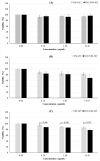Analysis of the Characteristics and Cytotoxicity of Titanium Dioxide Nanomaterials Following Simulated In Vitro Digestion
- PMID: 32748892
- PMCID: PMC7466536
- DOI: 10.3390/nano10081516
Analysis of the Characteristics and Cytotoxicity of Titanium Dioxide Nanomaterials Following Simulated In Vitro Digestion
Abstract
Several metallic nanomaterials (NMs), such as titanium dioxide nanomaterials (TiO2), present beneficial properties with a broad range of innovative applications. The human population is exposed to TiO2, particularly by ingestion, due to its increasing use as a food additive and inclusion in dietary supplements and food packaging materials. Whether this oral exposure may lead to adverse local or systemic outcomes has been the subject of research, but studies have generated contradictory results, reflecting differences in the physicochemical properties of the TiO2 studied, effects of the surrounding matrix, and modifications during digestion. This work aimed to investigate the toxic effects of three different TiO2 NMs (NM-103, NM-103 and NM-105) on the gastrointestinal tract cells, Caco-2 and HT29-MTX-E12, after the use of the standardized static INFOGEST 2.0 in vitro digestion method to mimic human digestion of TiO2, contributing to hazard assessment. The results show that, for one of the digested TiO2 NMs studied (NM-105), a more pronounced toxicity occurs after exposure of HT29-MTX-E12 intestinal cells, as compared to undigested NM, concomitantly with subtle changes in characteristics of the NM. Thus, the inclusion of the digestion simulation in the safety evaluation of ingested NMs through in vitro bioassays can better integrate the modifications that NMs suffer in the organism. It is expected that such an approach will reduce uncertainties in the hazard assessment of ingested NMs for human health.
Keywords: cytotoxicity; ingested titanium dioxide; nanomaterials; standardized in vitro digestion.
Conflict of interest statement
The authors declare no conflict of interest.
Figures





Similar articles
-
Investigation of the genotoxicity of digested titanium dioxide nanomaterials in human intestinal cells.Food Chem Toxicol. 2022 Mar;161:112841. doi: 10.1016/j.fct.2022.112841. Epub 2022 Jan 31. Food Chem Toxicol. 2022. PMID: 35093430
-
Cellular and Molecular Mechanisms of Toxicity of Ingested Titanium Dioxide Nanomaterials.Adv Exp Med Biol. 2022;1357:225-257. doi: 10.1007/978-3-030-88071-2_10. Adv Exp Med Biol. 2022. PMID: 35583647 Review.
-
Assessing the impact of TiO2 nanomaterials on intestinal cells: New evidence for epithelial translocation and potential pro-inflammatory effects.Toxicology. 2025 Feb;511:154066. doi: 10.1016/j.tox.2025.154066. Epub 2025 Jan 25. Toxicology. 2025. PMID: 39870156
-
Chronic effects of two rutile TiO2 nanomaterials in human intestinal and hepatic cell lines.Part Fibre Toxicol. 2022 May 17;19(1):37. doi: 10.1186/s12989-022-00470-1. Part Fibre Toxicol. 2022. PMID: 35578293 Free PMC article.
-
Relevance of Physicochemical Characterization of Nanomaterials for Understanding Nano-cellular Interactions.Adv Exp Med Biol. 2018;1048:123-142. doi: 10.1007/978-3-319-72041-8_8. Adv Exp Med Biol. 2018. PMID: 29453536 Review.
Cited by
-
Agglomeration Behavior and Fate of Food-Grade Titanium Dioxide in Human Gastrointestinal Digestion and in the Lysosomal Environment.Nanomaterials (Basel). 2023 Jun 22;13(13):1908. doi: 10.3390/nano13131908. Nanomaterials (Basel). 2023. PMID: 37446425 Free PMC article.
-
Gallic Acid-Functionalized, TiO2-Based Nanomaterial-Preparation, Physicochemical and Biological Properties.Materials (Basel). 2022 Jun 13;15(12):4177. doi: 10.3390/ma15124177. Materials (Basel). 2022. PMID: 35744240 Free PMC article.
-
Adverse Outcome Pathways Associated with the Ingestion of Titanium Dioxide Nanoparticles-A Systematic Review.Nanomaterials (Basel). 2022 Sep 21;12(19):3275. doi: 10.3390/nano12193275. Nanomaterials (Basel). 2022. PMID: 36234403 Free PMC article. Review.
-
Assessing the Toxicity of Metal- and Carbon-Based Nanomaterials In Vitro: Impact on Respiratory, Intestinal, Skin, and Immune Cell Lines.Int J Mol Sci. 2024 Oct 10;25(20):10910. doi: 10.3390/ijms252010910. Int J Mol Sci. 2024. PMID: 39456693 Free PMC article.
-
Behaviour of Titanium Dioxide Particles in Artificial Body Fluids and Human Blood Plasma.Int J Mol Sci. 2021 Sep 30;22(19):10614. doi: 10.3390/ijms221910614. Int J Mol Sci. 2021. PMID: 34638952 Free PMC article.
References
-
- Peters R., Weigel S., Marvin H., Bouwmeester H., Aschberger K., Rauscher H., Amenta V., Arena M., Botelho Moniz F., Gottardo S., et al. Inventory of Nanotechnology Applications in the Agricultural, Feed and Food Sector. EFSA Supporting Publication; Parma, Italy: 2014. [(accessed on 10 December 2019)]. pp. 1–125. Available online: www.efsa.europa.eu/publications.
-
- Gómez H.C., Serpa A., Velásquez-Cock J., Gañán P., Castro C., Vélez L., Zuluaga R. Vegetable nanocellulose in food science: A review. Food Hydrocoll. 2016;57:178–186. doi: 10.1016/j.foodhyd.2016.01.023. - DOI
Grants and funding
- PTDC/SAU-PUB/29481/2017/Portuguese Foundation for Science and Technology FCT/MCTES through national funds (PIDDAC)
- UIDB/00009/2020 (Centre for Toxicogenomics and Human Health - ToxOmics, FCT)/Portuguese Foundation for Science and Technology FCT/MCTES
- iMed.ULisboa (Pest-UID/DTP/04138/2019)/Portuguese Foundation for Science and Technology FCT/MCTES
- CESAM (UIDP/50017/2020+UIDB/50017/2020)/Portuguese Foundation for Science and Technology FCT/MCTES through national funds
LinkOut - more resources
Full Text Sources

